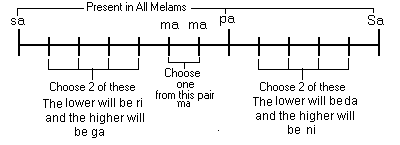Melam System in Detail (1)
We have briefly touched the concept of Melam in discussing the Raagam classification. Historically, the concept of building scales by selecting notes is about 6 centuries old (attributed to Vidhyaaranya 15th Century). Earlier the entire theory of Indian music was based on 22 'Sruthis' in an octave. Seven notes, each with certain number of 'Sruthis' above the previous note were considered as 'Suddha'. When some notes 'sacrificed' their sruthi values they became 'Vikrta' which were also called as 'Anthara' or 'Saadharana' (intermediate). Raagaas were also defined by terms like Graha ( starting note), Amsa (dominant) and Nyasa (ending note). The concept of Tonic or Aadhaara Sruthi was also perhaps not well evolved as even Shadjam could become 'Vikrta'.
After many attempts by theorists to define a system based on selection of notes, the current system was evolveed by Venkatamakhi in his work Chathurdandiprakaasika (c. 1620). We still use his system with nomenclature modified and extended by others (for instance Govinda (1750-1800) in his Sangrahachoodaamani). All the works use only 12 positions in an octave though 16 names are used. The shift to 12 positions from 22 Sruthis might have been influenced by the development of fretted instruments. It may be noted that even today, fixing frets on a Veena is called 'Melam fixing' in the south. The word 'That' used in Hindustani music is also mentioned in one work of the Mela period (Raagavibhodham of Somanatha) to indicate fixing of frets.
With sa and pa having no variations, the simple informal system of 2 variations each for ri,ga,ma,da and ni can give 32 combinations, but would not include some raagams in vogue like Varaali or Naata. Venkatamakhi proposed only 2 variations for ma, but for the rest his system is different. With sa,ma and pa having been taken care of, we are left with four positions between sa and the lower ma and 4 positions between pa and upper Sa.

